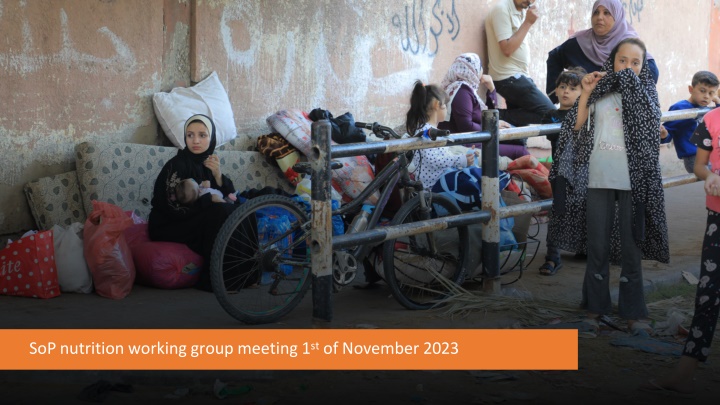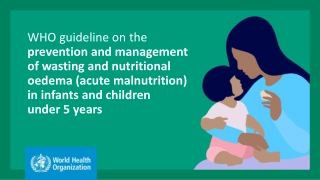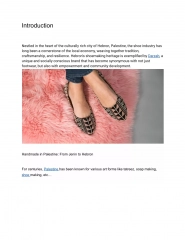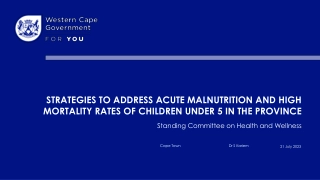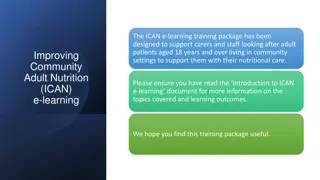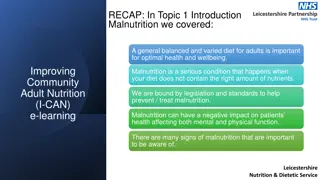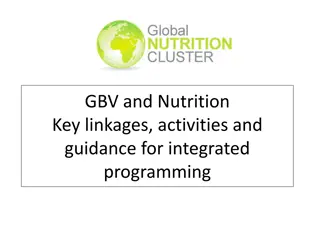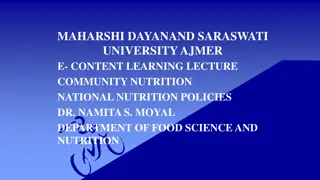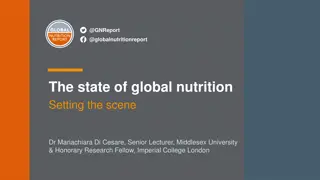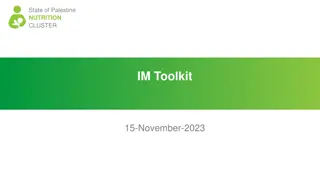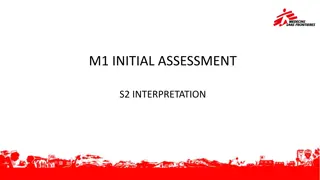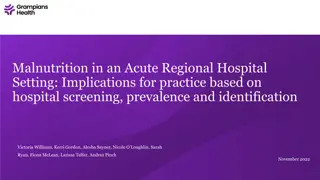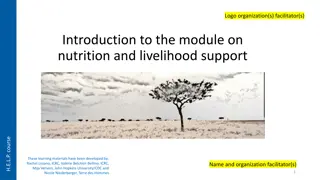Nutrition Emergency Response in Palestine: Addressing Wasting and Malnutrition
The nutrition situation in Gaza, Palestine is dire, with a significant proportion of the population experiencing food insecurity and malnutrition. A flash appeal highlights the urgent need for funding to support nutrition interventions, especially for vulnerable groups such as infants and pregnant women. Projections indicate a concerning increase in wasting burden, requiring immediate action to prevent further deterioration of the situation.
Download Presentation

Please find below an Image/Link to download the presentation.
The content on the website is provided AS IS for your information and personal use only. It may not be sold, licensed, or shared on other websites without obtaining consent from the author.If you encounter any issues during the download, it is possible that the publisher has removed the file from their server.
You are allowed to download the files provided on this website for personal or commercial use, subject to the condition that they are used lawfully. All files are the property of their respective owners.
The content on the website is provided AS IS for your information and personal use only. It may not be sold, licensed, or shared on other websites without obtaining consent from the author.
E N D
Presentation Transcript
Flash appeal- Nutrition 23.4 million USD is needed for 3 months response (out of that 19.3 million is needed for Gaza) 83 million is needed for 12 months response (out of it 68.6 million is needed for Gaza) 100% oF Gaza population considered as PiN (over 2 million) in addition to 600,000 as PiN from WB
Nutrition FA main interventions Infant 0-6 mo. Secure RUIF for non- breastfeed infants IYCF-E ECD-E Management of Wasting Children 6-24 mo. Provide MQ-LNS/ SQ-LNS Vit A supplementation IYCF-E ECD-E Early detection & management of Wasting Children 24-59 mo. Provide HEB Provide MNPs Vit A supplementation Early detection & management of Wasting Deworming PLWs Provide MQ- LNS/HEB Provide MNPs Iron/folate or MMS supplementation CVA for Nutrition
Food insecurity: Pre conflict, WFP estimated that 1.8 million Palestinians were food insecure In Gaza (64%). Post conflict, 100% of Gaza population (approximately 2 million) are considered food insecure Water and sanitation: Pre conflict, UNRWA reported that over 90% of the water in Gaza has been deemed unfit for human consumption. Post conflict, WASH cluster estimated 94% of reduction in the water supply. Health: Pre conflict: service coverage index as measured by the Universal Healthcare Coverage (UHC) is 64 and has remained essentially unchanged over the past two decades. UNRWA provides health-care services to the vast majority of the over 1.2 million Palestine refugees in Gaza through 22 centers Post conflict, according to WHO, only 37% of MOH primary care facilities are operational, and those which are operating are facing severe shortages of medical supplies, damage from airstrikes, and extended electricity outages. 15 out of 22 UNRWA Health Centers across the Gaza Strip are providing PHC services Due to the deterioration of the underlying determinants of malnutrition, there is a need to estimate the increase of burden of wasting
The scenarios we are expecting ?? With the current situation and the expected significant deterioration on nutrition vulnerability and need for nutrition services, it is important to project and estimate the expected increase in wasting burden To Estimate the projected wasting burden and because of the anticipated further deterioration of the underlying determinants of malnutrition, Current incidence correction factor of used 2.6 & 3 for the WB and Gaza, respectively Projection incidence correction factor of 3 and 3.8 to be used for the WB and Gaza, respectively By this projection, nearly 30,000 children across the State of Palestine are at risk of suffering from wasting and 15,000 of these children are projected to face severe wasting, putting them at imminent risk of death.
Child wasting is projected to increase by 27% in Gaza meaning that nearly 10,000 children across Gaza are at risk of suffering from wasting and 5,000 of these children are projected to face severe wasting, putting them at imminent risk of death.
Child wasting is projected to increase by 15% in West Bank meaning that nearly 20,000 children across West Bank are at risk of suffering from wasting and 10,000 of these children are projected to face severe wasting, putting them at imminent risk of death.
Priorities Release nutrition WG infographic and advocacy messages Working on SoP specific SOPs for BMS, safe spaces, MNs supplementation & Wasting management Finalize the Partners capacity mapping/ Capacity development needs Finalize the projections on the impact of the current situation on the nutrition Develop & update Nutrition WG Partners mapping- 4Ws Support the establishment of BMS code monitoring system Further strengthen nutrition coordination, how best we maximized partners capacity and mobilize resources for nutrition Follow up the nutrition commodities pipeline status, to ensure the timely delivery of nutrition supplies.
Important matrixes/ forms have been shared SoP nutrition working group 3Ws database SoP nutrition working group contact list SoP Nutrition working group capacity mapping matrix (capacity strengthen+ Supplies) SoP nutrition working group BMS code violation reporting form
Nutrition WG infographics to be released today
Partners updates MOH will provide all the needed technical support in developing the simplified SoP guidelines to hide the nutrition response. UNRWA is working on a 90 days response including nutrition interventions per age group, the interventions include the provision of ready to use food (details on quantities to be shared later) WFP managed to move ready to use ration to Gaza, while planning to introduce the special nutritious age-appropriate food for children and mothers (details on quantities to be shared later) UNICEF managed to secure the needed quantities of RUTF for the FA needs, as well as procuring the needed quantities of RUIF in baches to address the need of non-breastfed infant. UNICEF is working on scaling up nutrition preventive and curative interventions, UNICEF is interested to expand their partnerships on the ground to strengthen service delivery capacities
We need to act immediately to prevent further deterioration of the nutritional status of the most vulnerable children and women
